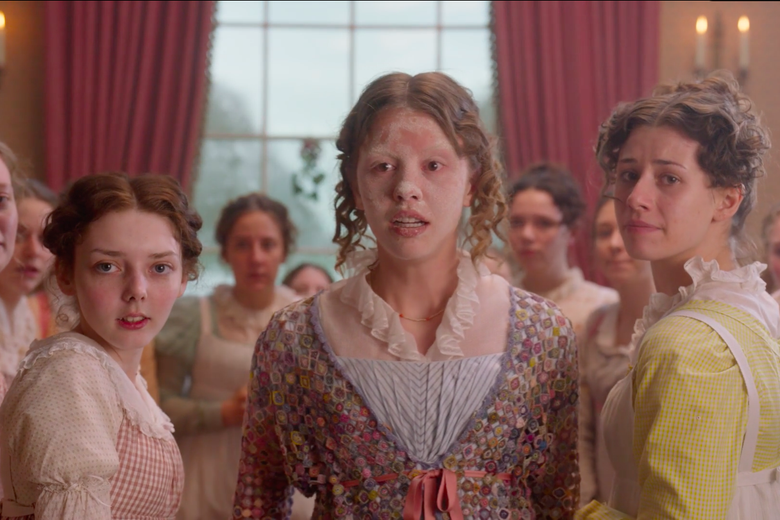
Mia Goth, be-floured, in Emma.
Focus Features
There are already many versions of Jane Austen’s Emma, but Autumn de Wilde’s adaption manages to bring something new to the table: bullet pudding.
In the new Emma, which stars Anya Taylor-Joy as Austen’s titular matchmaker, there’s a scene where Emma’s best friend Harriet (Mia Goth) is shown lifting away a mold to reveal what looks like a sandcastle made of flour. Surrounded by a gaggle of her fellow boarders at Mrs. Goddard’s, Harriet then carefully drops what looks like a coin on top of this “cake.” Amid much giggling and non-verbal exclamations (Austen readers might recall that many of her characters frequently “cry” rather than “say” things) the girls take turns cutting away slices of the flour cake with a butter knife, taking care not to touch the coin at the center. Soon there is nothing left but a cylinder of flour with the coin at the top. Harriet is the one who ultimately knocks the coin off, and as a penalty for destroying the cake, she has her face pushed into the platter of flour. She ultimately rises with the coin between her lips, flour-covered and triumphant. All this happens to much laughter and applause, but the funniest part comes at the end, when the laughter abruptly dies down as the girls notice a disapproving Emma standing behind Harriet. She doesn’t say anything, but Harriet looks chastised. “Miss Woodhouse!” she cries, with a guilty curtsy.
Focus Features
This is bullet pudding. The game is never named in the movie, but from the scene it is suggested that it is not a dignified pursuit for genteel young ladies such as Emma, and such as Emma wants Harriet to be. This scene was invented for the film version, but it feels faithful to the source material. This is in part because it conforms to the overall dynamic of Emma and Harriet’s uneven friendship: the stern, domineering Emma setting the agenda, and an uncertain but worshipful Harriet who is by turns rebellious and penitent.
Bullet pudding was most definitely part of Austen’s Regency world. According to Jane Struthers in The Book of Christmas, Jane Austen’s family enjoyed the game every Christmas. In Pudding: A Global History, Jeri Quinzio writes that although she does not know whether Austen herself ever played this game, her niece certainly did. Quinzio quotes from a 1804 letter by Austen’s niece, Fanny Austen Knight, in which Fanny describes the rules:
You must have a large pewter dish filled with flour which you must pile up into a sort of pudding with a peak at the top, you must then lay a Bullet at the top & everybody cuts a slice of it & the person that is cutting it when the Bullet falls must poke about with their noise & chins till they find it & then take it out with their mouths which makes them strange figures all covered with flour but the worst is that you must not laugh for fear of the flour getting up your nose & mouth & choking you. You must not use your hands in taking the bullet out.
Bullet pudding is not the only parlor activity that gets screen time in Emma: the movie’s social gatherings also feature card games and competitive piano recitals. Even the country dance, the structure of which figures prominently in the plot, has the character of a game requiring a set number of players. These period details are not only enjoyable to watch (perhaps with the exception of Mr. Knightley’s objectively repellent, if historically accurate, side whiskers), they’re also crucial to the narrative. They flesh out characters, act as relationship foils, and help establish the social contours of the Emma universe—maybe not one we’d like to inhabit, but certainly one we might be willing to spend two hours luxuriating in, even if we end up with a mouth full of flour.
Readers like you make our work possible. Help us continue to provide the reporting, commentary and criticism you won’t find anywhere else.
Join Slate Plusfrom Slate Magazine https://ift.tt/3c2m3k3
via IFTTT
沒有留言:
張貼留言